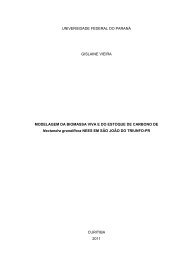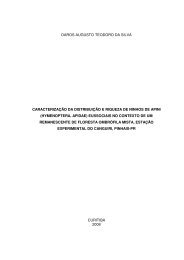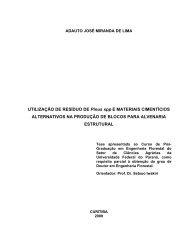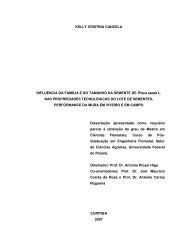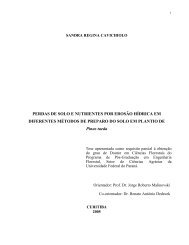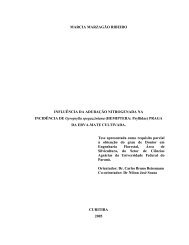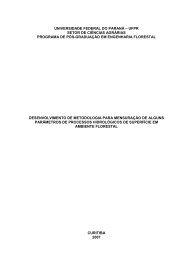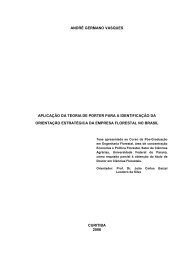Tese em PDF - departamento de engenharia florestal - ufpr ...
Tese em PDF - departamento de engenharia florestal - ufpr ...
Tese em PDF - departamento de engenharia florestal - ufpr ...
You also want an ePaper? Increase the reach of your titles
YUMPU automatically turns print PDFs into web optimized ePapers that Google loves.
of the Jacuí River. For each sample’s unit, all woody plants with a diameter at breast<br />
height ≥ 5 cm were measured and i<strong>de</strong>ntified, and surface soil samples were collected<br />
for fertility and granulometric composition analysis. In this study, 16 soil classes were<br />
<strong>de</strong>termined up to the fourth categorical level in 12 geomorphological and soil<br />
compartments, and 3757 individuals belonging to 95 species were sampled. The<br />
richest families in species are: Myrtaceae (16), Myrsinaceae (6), Fabaceae (5),<br />
Euphorbiaceae (4), Rubiaceae (4) and Sapotaceae (4). In the floristic similarity<br />
analysis, three major groups were classified, and they had high correlation with<br />
environmental conditions and spatial distribution on the topographic gradient. For<br />
each group, the representation of the species was <strong>de</strong>termined through the ecological<br />
guilds of dispersion, stratification and regeneration, as well as via the geographical<br />
contingent of the species. The geographical contingent and ecological patterns of the<br />
species were different between groups. The ordination analysis of the environment<br />
(NMS) revealed significant differences between the sampling points of the plain and<br />
slopes. Elevation, slope, soil texture, H + Al and CEC were the most important<br />
variables in the analysis. The floristic ordination analysis (DCA) compl<strong>em</strong>ented the<br />
cluster analysis by strengthening the existence of three major tree communities,<br />
spatially correlated with the relief position, at different stages of conservation,<br />
diversity and phytosociology. These were termed formation, submontane (FS),<br />
alluvial (FA), and the area dominated by both teams (FA/FS). The FA/FS area proved<br />
to be more diverse than the others, with lower ecological dominance in narrow<br />
fragments. The submontane presented the highest <strong>de</strong>nsity of individuals in larger<br />
diameter and height classes, due to the protected location in small valleys, with high<br />
ecological dominance by a particular shadow species, Actinost<strong>em</strong>on concolor. The<br />
alluvial was characterized by smaller trees and the overwhelming presence of<br />
Sebastiania commersoniana in narrow corridors. The patterns of the forest typologies<br />
of the watershed were sorted mainly by environmental gradients and relief forms, the<br />
sizes of the fragments linked to the disturbances, conditioning different successional<br />
stages, that impact on the light gradient within the fragments and on environmental<br />
control over soil moisture. This set of variables <strong>de</strong>termined the distribution of the<br />
main species and communities in the watershed.<br />
Keywords: Pampa Biome, community ecology, forest dynamics, soil-plant<br />
relationship, arboreal species, forest soils.<br />
III




